 |
What part of the electrical system does the HICAP•SCDC kit upgrade? |
 |
|
 |
As seen below in the purple outline, the starting circuit is separate from almost all of the rest of the loom. It is only used for starting the bike and is dormant once the engine is running. The HICAP•SCDC kit upgrades the 6 points in the circuit by between 150%, (on a new bike), and 300% (on a bike that has seen some years and miles). The OE copper leads deteriorate due to the heat, high current flow cycles, and the wide-bandwidth vibration when the engine is running.
|
 |
|
 |
 |
 |
|
 |
As seen above, the starting circuit is a single-use portion of the bike harness and is directly connected to the battery via the solenoid. The main ground lead is also the return path for all of the other electrical circuits in the system and accounts for why many riders report better engine running after upgrading to the HICAP•SCDC.
|
 |
 |
 |
What is the advantage to the HICAP•SCDC kit?
|
 |
|
 |
As you will see further down the page, many expensive components experience excess wear when the engine is cranked for extended periods of time. By extended we mean 3-4 seconds vs. 1 second. The chart below shows that by reducing the periods from 3 seconds to 1 second, you reduce the wear by 67%. 2 tries to start the engine of 2 seconds each, when reduced to a half-second results in an 88% reduction in wear.
|
 |
|
 |
 |
 |
|
 |
It is obvious that a low-cost, easy to install upgrade that reduces the wear on expensive components is a very good value. Imagine being able to increase your tire mileage by a factor of 2 or 3 with the same traction and handling, for half the cost of a replacement tire.
|
 |
 |
 |
Is the kit difficult to install? Do I need to take the bike to a shop to get it installed?
|
 |
|
 |
If you feel you could change out your battery, you can install the HICAP•SCDC kit. It is just 6 connections and the kits are precisely sized to your bike model. We have sold close to 10,000 HICAP•SCDC kits to riders in 66+ countries and a very high percentage of those kits were installed by the rider/self-mechanic.
|
 |
|
 |
 |
 |
|
 |
Most bikes are a 45-90 minutes install with most of that time being spent getting the fairing off the side of the bike. Many thousands of riders have successfully installed the kit using just the normal tools in a bike toolkit. Nothing specialized is needed.
|
 |
 |
 |
Was my bike supplied with a weak, under engineered starting system?
|
 |
|
 |
No, as seen below, the entire circuit is correctly engineered for the **electrical** load. But they have not accounted for the physical deterioration that the circuit experiences due to the vibration, heat cycles and high current flow through the copper atoms.
|
 |
|
 |
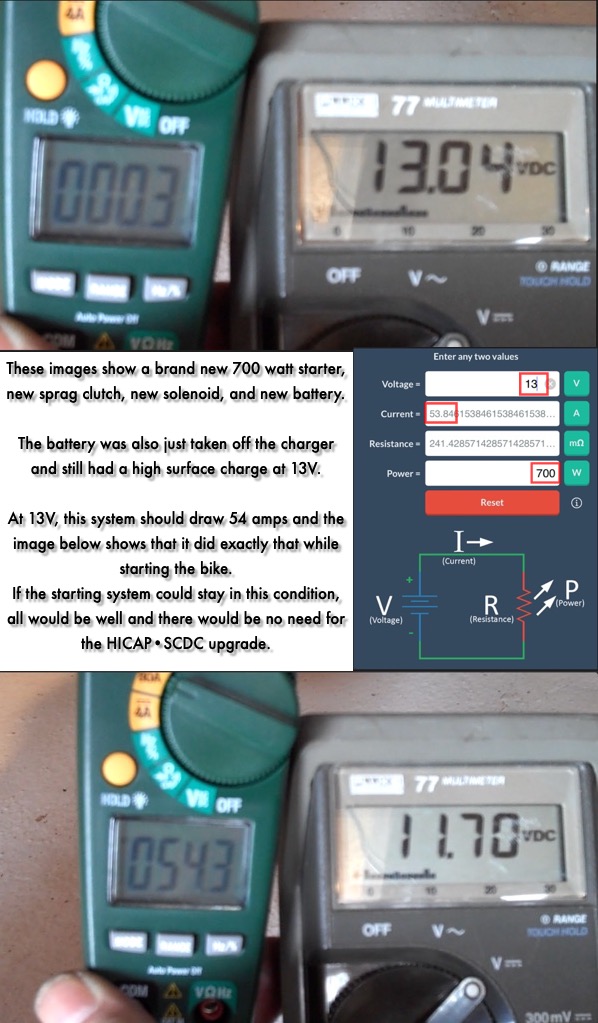 |
 |
|
 |
All of the starting circuits on all the makes and models we support are properly engineered for the electrical requirements of starting the engine. But that is when the circuit, starter and sprag clutch are new and have no wear. The wear increases the load of starting the bike and the copper in the wire degrades due to the very high current draw and contant wide-bandwidth vibration.
|
 |
 |
 |
What else happens as the wire degrades?
|
 |
|
 |
The bike shown below is a Triumph Tiger 1050. It became very difficult to start and as you can see on the DC amp clamp meter, the starting system is attempting to draw 110 amps, about twice what it would draw when it was new. This added draw causes the starting event to be extended which causes the damage to the components as we show below. The battery is also being degraded at an accelerated rate as SLI batteries are only really capable of a 2-3 second draw and then they need to be allowed to rest for about 2 minutes to recover. No one ever waits the 2 minutes and so the battery life is shortened by 30-60 %.
|
 |
|
 |
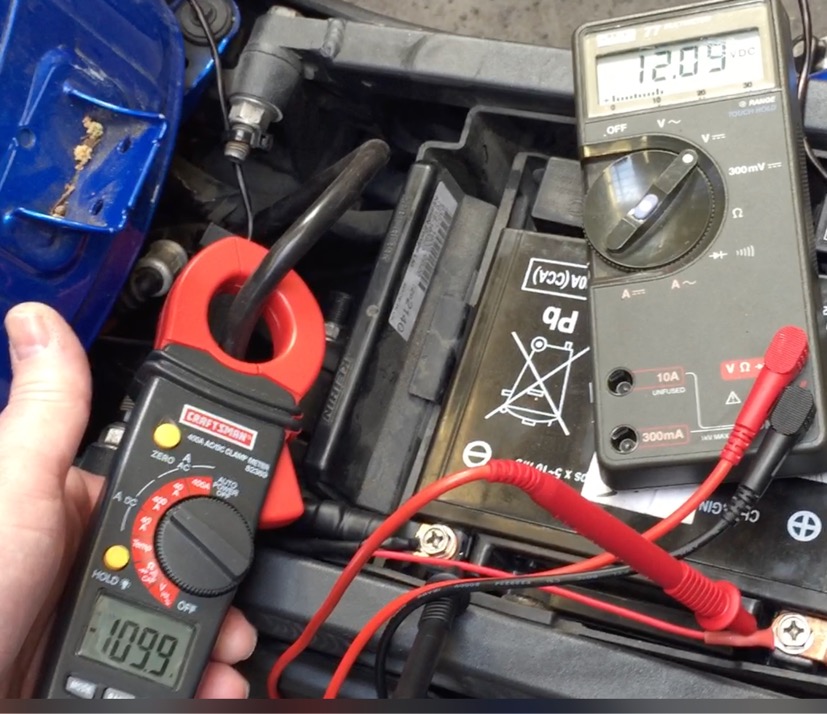 |
 |
|
 |
The Tiger was the owners commute vehicle and so the daily stress of wondering if it would start was taking a toll. After installing the HICAP•SCDC, he was back to less than 1 second starts.
|
 |
 |
 |
What components are degraded due to extended cranking of the engine during starting?
|
 |
|
 |
In addition to the accelerated wear on the battery, there are 5 major mechanical components that wear. As they wear they increase the load on the starter which just draws more current in trying to turn the engine over. The whole scenario just causes everything to get worse. To replace any of these parts requires a major repair which includes removing the left side cover of the engine case.
|
 |
|
 |
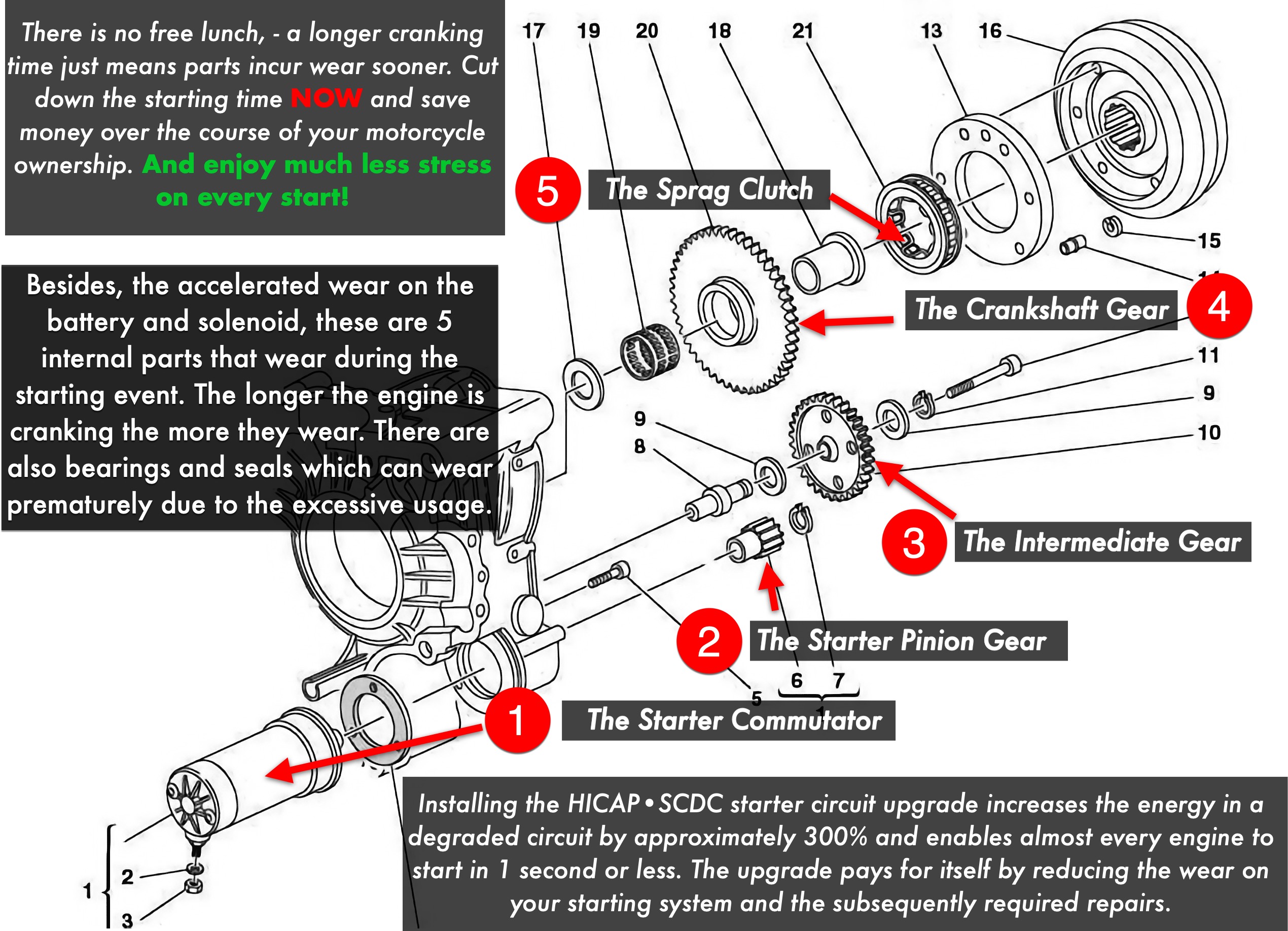 |
 |
|
 |
Reducing the starting event to the very shortest time possible is the best way to minimize the costs of ownership.
|
 |
 |
 |
What extra wear is happening inside the engine?
|
 |
|
 |
All of the parts are experiencing added wear. Everyone knows that if you keep your engine up near the redline, you will experience more wear than if you keep it in the midrange RPM. The same principle holds true for the starting system. More usage means more wear.
|
 |
|
 |
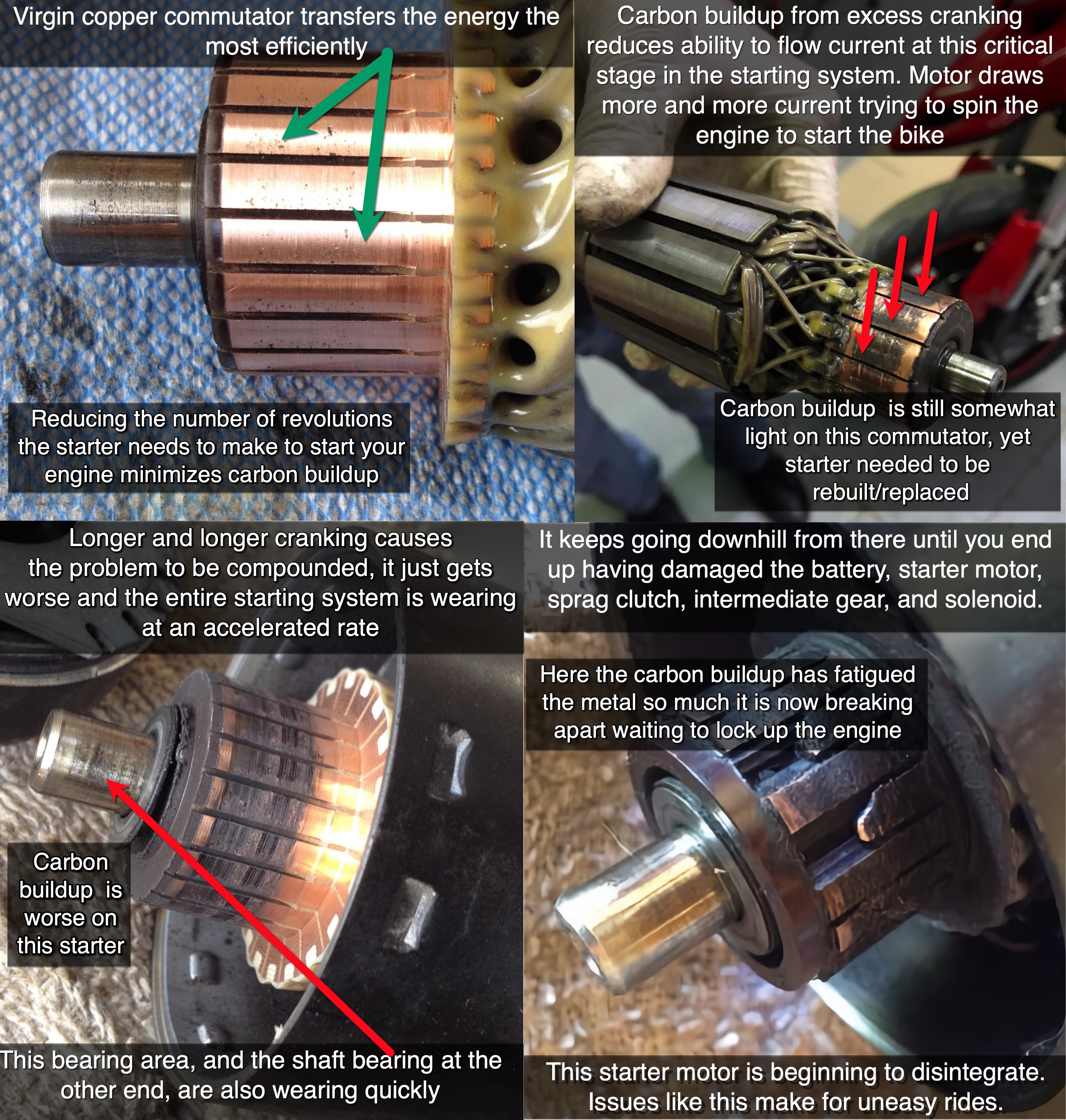 |
 |
|
 |
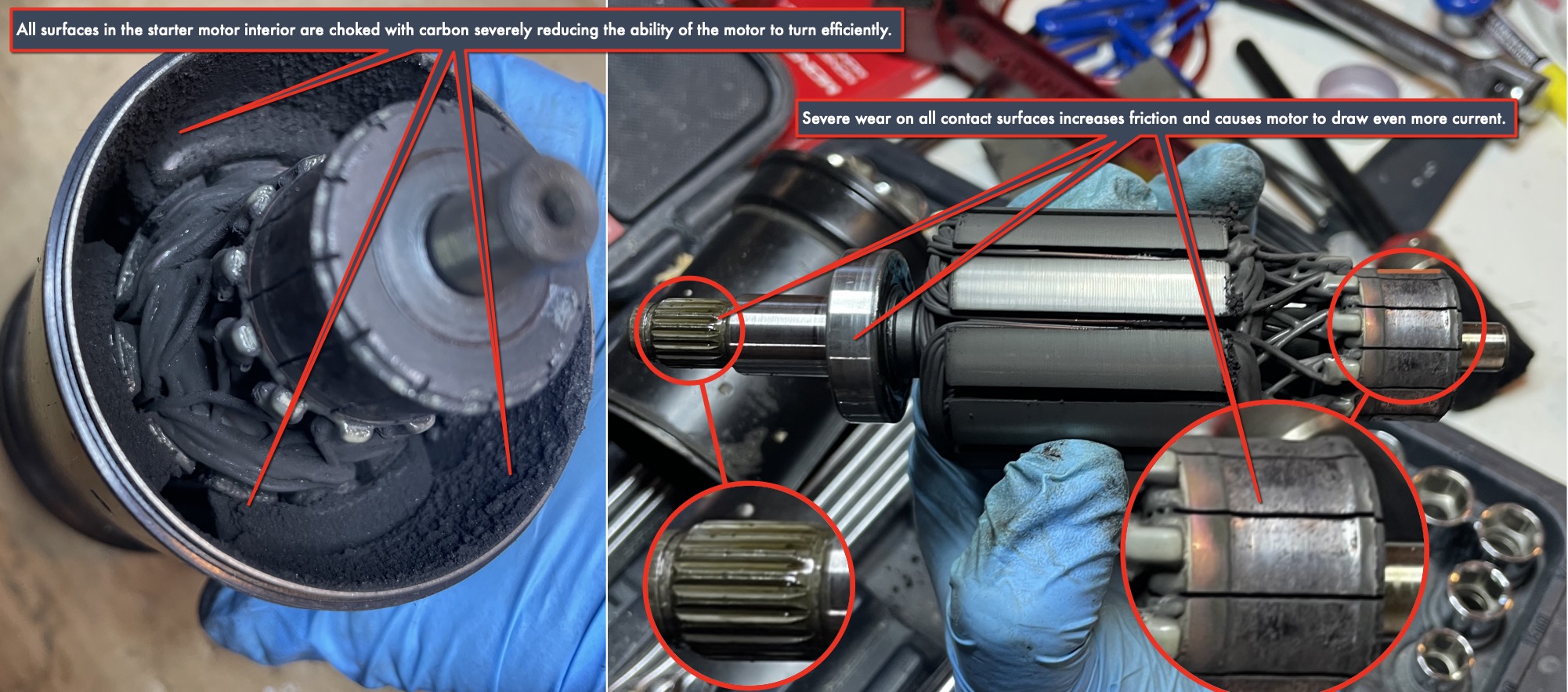 |
 |
|
 |
The carbon buildup makes the engine pull more current and extends the starting event.
|
 |
 |
 |
What is a sprag clutch and why does my engine need one?
|
 |
|
 |
The sprag clutch is a one-way drive system. It grips under the starting conditions and freewheels once the engine is started. If you know how the derailleur on a bicycle works, it is the same principle. While a motorcycle engine is trying to start, it protects the engine from a backfire (that would push the crankshaft backwards) or if the starter cannot turn the engine fully over and the compression would push the engine backwards. The sprag is spinning (either gripping or freewheeling) 100% of the time the engine is either starting or running.
|
 |
|
 |
 |
 |
|
 |
As the spinning parts wear the mating surfaces get rougher which just adds friction and load to the work the starter motor has to do which causes it to draw more current to get the engine to turn over.
|
 |
 |
 |
So, how does the wire wear?
|
 |
|
 |
Copper is the 2nd most efficient conductor, only silver is more conductive. But the high cost of silver makes it a poor value. Copper has a very uniform crystal lattice structure and that is why it is so conductive.
|
 |
|
 |
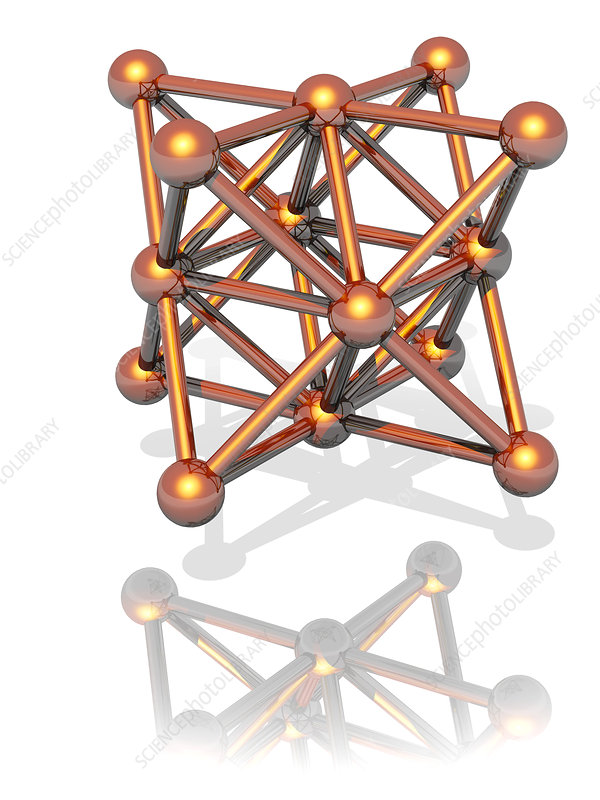 |
 |
|
 |
If we could maintain this crytal structure the copper would not lose its ability to conduct electricity.
|
 |
 |
 |
What happens to cause the loss of conductivity?
|
 |
|
 |
Energy cannot be created or destroyed, it can only be changed into another form. The vibrations in the engine travel through the engine cases to the air and that is what you hear when the engine is running. The energy was conducted into the air and is being dissipated by moving the air molecules around. But that same energy is also traveling through the copper and is trying to move the copper atoms. But they are held in place by the weak nuclear force. The energy constantly tries to disrupt the lattice as it travels through the copper and over time the lattice structure deteriorates, and the copper is essentially getting worn out. On halogen or incandescent bulbs they grow dimmer over time and on the starting circuit the time to get the bike to start just gets longer and longer.
|
 |
|
 |
|
 |
|
 |
These animations show 4 of the ways that the vibrational energy tries to disrupt the crystal structure. Note that they pull and push and shear the structure. In air or water, the energy has an easy time just pushing the molecules around but not in solid materials like stone or metal.
|
 |
 |
 |
So, the starter motor gets clogged with carbon, the sprag and the other geared components get worn, the copper lattice gets disrupted, what else is happening? Is there anything else that is being degraded?
|
 |
|
 |
The final problems are;
copper loses some of its ability to flow current when hot and that loss of conductivity can
cause your bike to become difficult to start after you gas up
and finally, cause the engine to die while you are at a traffic light
When the copper has been highly compromised and the starter mechanicals have worn
the entire load can draw the battery down below the minimum required by the ECU and it will reset while trying to start the engine
Add in the losses from the heat and you have ongoing starting/running issues
We have received requests to develop kits for a number of bikes that have developed this problem. Once the HICAP•SCDC is installed all of the problems are gone.
|
 |
|
 |
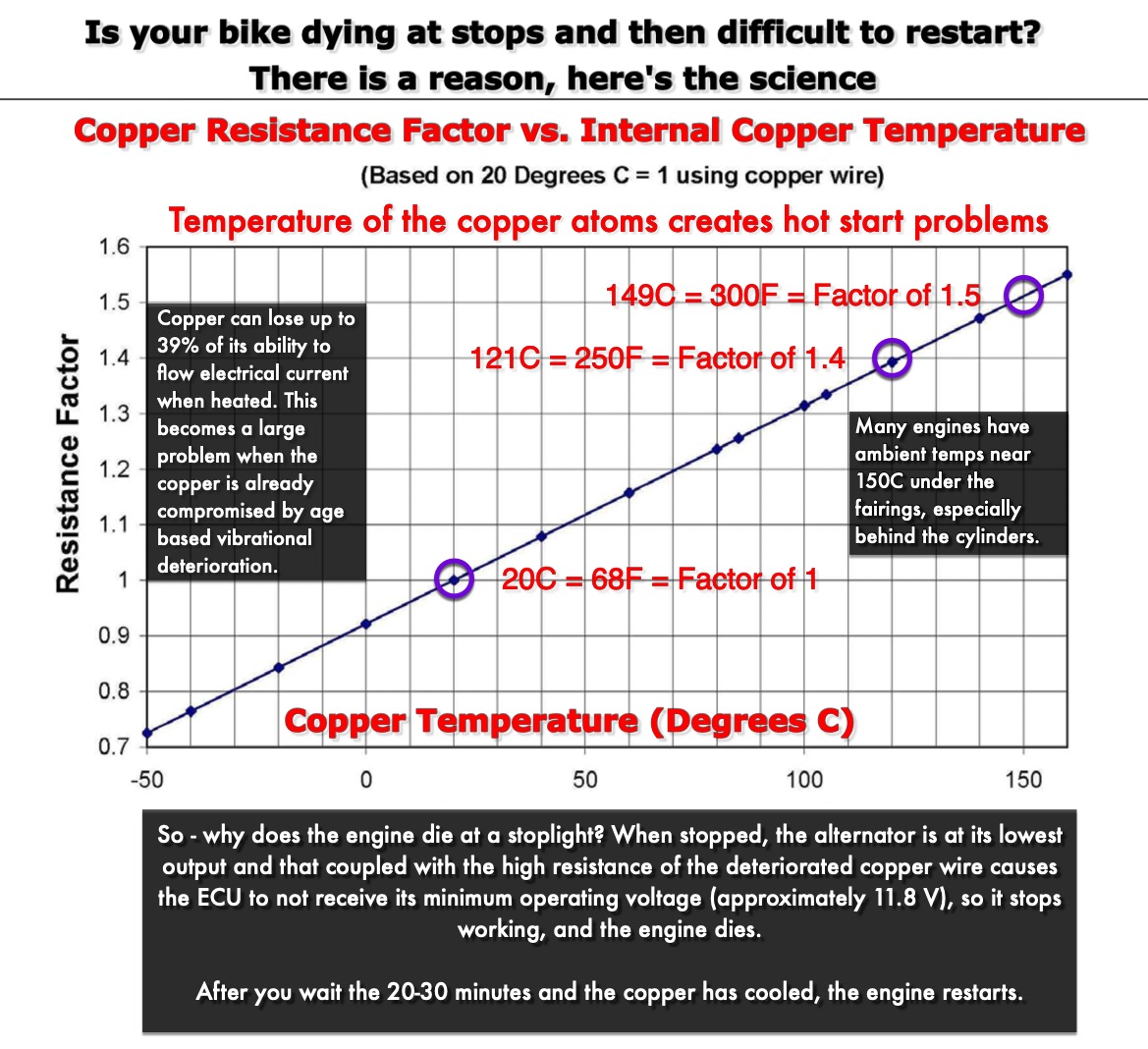 |
 |
|
 |
The engine dying at stoplights and the ECU resetting (when trying to start your bike), are the 2 most severe indications that you need to upgrade the starting circuit to get your bike back closer to a state of high reliability.
|
 |
 |
 |
What about those lower cost kits that claim the Motolectric HICAP•SCDC is over engineered?
|
 |
|
 |
As you can see below and as we detailed above, if the load that the starter needed to overcome stayed constant then yes, the 16mm wire that the OE makers, and the low cost alternatives, use would be sufficient. But there are bikes on the road with circuits that are 10 feet (3 meters) long and as the work to be done increases you quickly need more energy in the circuit than what 16mm can deliver.
|
 |
|
 |
 |
 |
|
 |
Even up to a 10 foot circuit can get by with 6 GA (16mm) wire but as soon as the wear sets in and you get anywhere near 105 amps of current draw, 16mm is underspec. The next metric size up jumps to 25mm and is just too large, too expensive to source, and very difficult to fabricate into a set of leads or install on a motorcycle. Our choice of AWG 4GA wire is based on a careful evaluation of all the details needed to deliver a high value kit.
|
 |
 |
 |
How much more energy is in the HICAP•SCDC vs. the OE or the low cost alternatives?
|
 |
|
 |
As this chart details, there is approximately 25% more energy in the HICAP•SCDC kit vs. the virgin OE circuit or the copycat products. The alternatives are often only 10-15% less money and you do all that work installing the kit just to end up back where you started out.
|
 |
|
 |
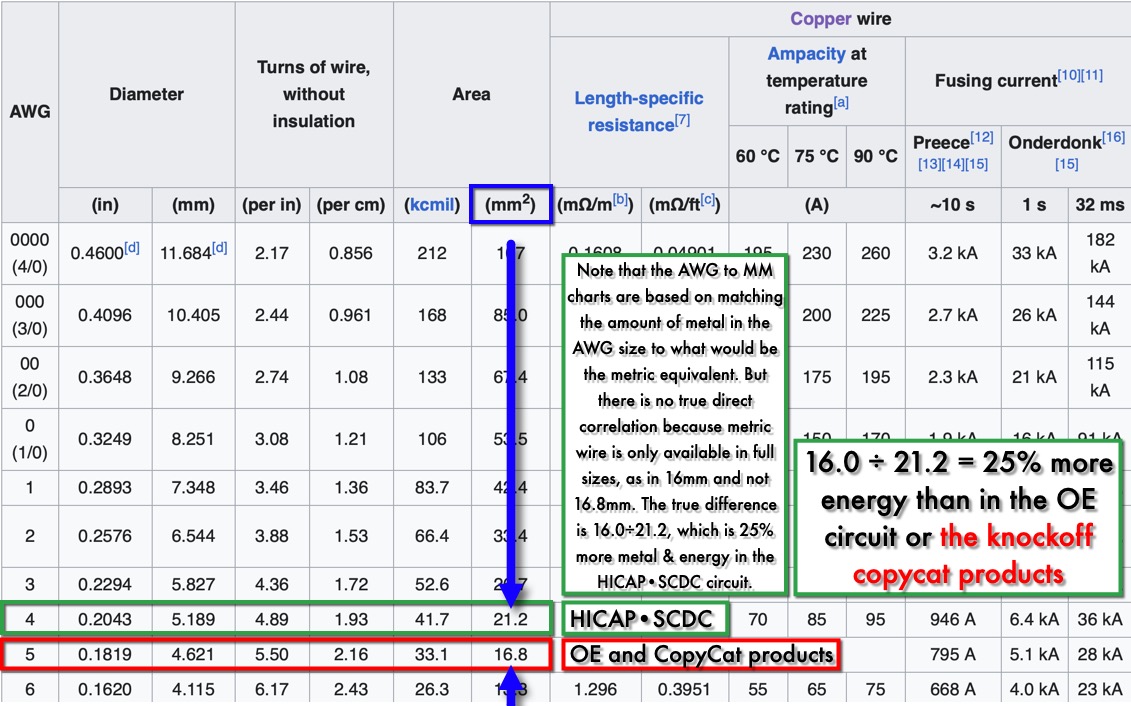 |
 |
|
 |
We have had riders who have bought the lower cost alternatives, become very upset when they realized they did not buy our HICAP•SCDC but a knockoff that used our HICAP trademark in the product listing.
|
 |
 |
 |
Is there anything else that the HICAP•SCDC offers beyond what has been stated?
|
 |
|
 |
Yes, our use of the highest purity copper and a high strand count wire pays high dividends in the longevity of the product performance. All energy always looks for the easiest way to be dissipated. So, if there is an airspace, it will move the air molecules. If there is a thicker strand, the energy will travel up the strand and outward towards the surface and then into the airspace around the strand. But with larger strands it must travel through more solid metal to get to the airspace and in so doing it disrupts more of the metal vs. traveling a shorter distance.
|
 |
|
 |
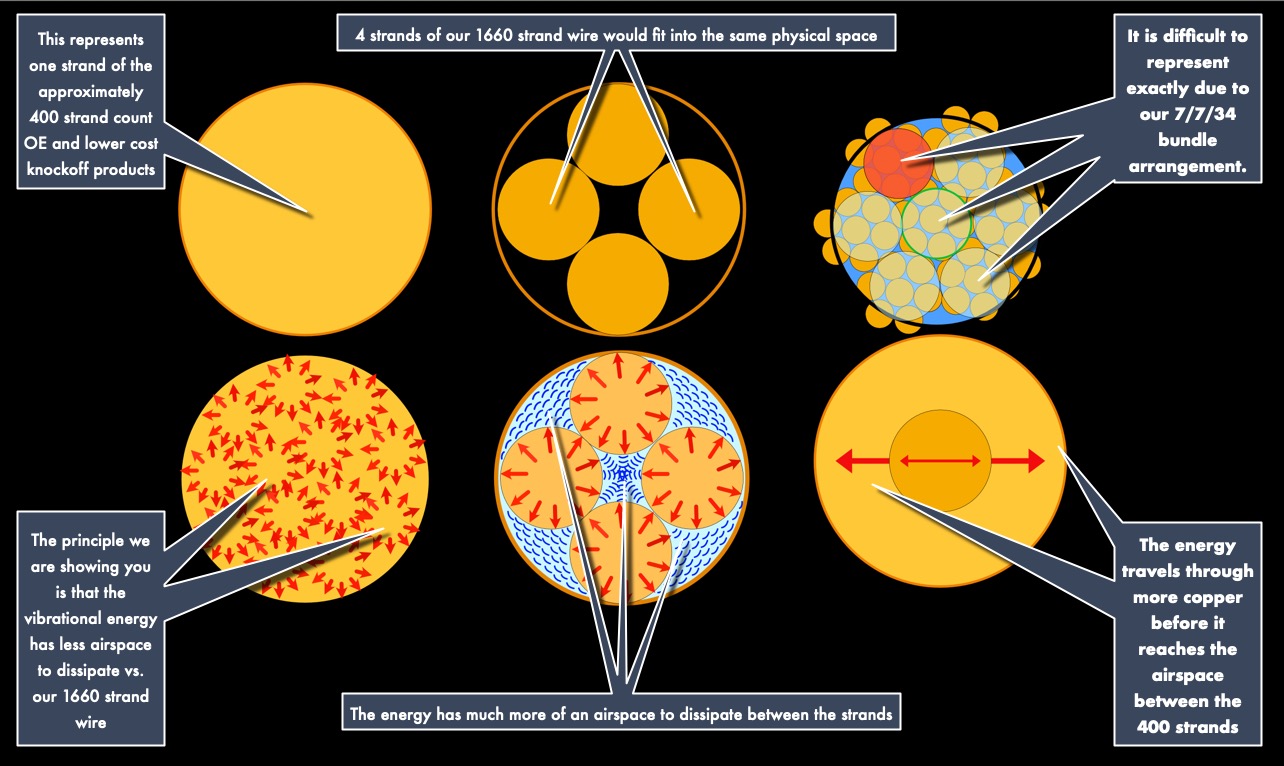 |
 |
|
 |
In addition to making the HICAP•SCDC leads very easy to manipulate during the installation, the much higher strand count dissipates the energy more efficiently and that allows the copper to maintain its performance for a much longer time.
There are bikes in the field with the HICAP•SCDC kit installed from 13 years ago that still start in less than 1 second.
|
 |
 |